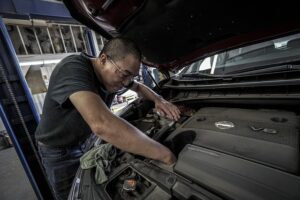Hydroplaning is a horror we wish it never happens to any of us. The sudden terror of our car spinning out of control and going dangerously fast when we least expect it. Let’s be honest. If you’ve ever been in this situation, you must have a glimpse of God waving his hand to you. But the good news is, there are plenty of simple measures you can take to prevent hydroplaning before it happens. Today, I’ll be providing some easy tips that’ll help keep your vehicle — and you! — safe while driving under wet weather conditions.
Spot the Conditions When Hydroplaning Is More Likely to Occur
 Knowing the conditions in which hydroplaning is more likely to occur can help you avoid it. Generally, hydroplaning is more likely to happen when there’s a lot of water on the road, and your tire pressure is low, or if you’re driving too fast for the current weather conditions. So it’s highly recommended to check your tires before heading out and maintain the recommended tire pressure for your vehicle. Also, be sure to reduce speed if you notice the roads are wet.
Knowing the conditions in which hydroplaning is more likely to occur can help you avoid it. Generally, hydroplaning is more likely to happen when there’s a lot of water on the road, and your tire pressure is low, or if you’re driving too fast for the current weather conditions. So it’s highly recommended to check your tires before heading out and maintain the recommended tire pressure for your vehicle. Also, be sure to reduce speed if you notice the roads are wet.
Maintain Proper Tire Inflation and Tread Depth
Speaking of checking your tire pressure, it can be a matter of life and death for you and others on the road. Especially during wet weather conditions, properly inflated tires can help reduce the chances of hydroplaning by providing better grip on slippery roads. Additionally, having enough tread depth on your tires is also essential to prevent hydroplaning, so it’s crucial to check your tire tread regularly. On top of that, your tire manufacturer may recommend a specific type of tire for more traction during wet road conditions.
Avoid Over-Accelerating and Braking Abruptly
Driving in wet road conditions requires extra caution and attention. It’s best to keep your speed low, to avoid hydroplaning, as well as over-acceleration and abrupt braking. Over-accelerating can cause water buildups in front of your tires, resulting in sudden drops in traction and increasing the chances of hydroplaning. Similarly, abrupt braking can cause your car to skid on a wet surface, so it’s important to maintain safe distances between you and the vehicle in front of you while driving.
Keep Your Windshield and Wipers Clear
 The last basic rule of thumb is to keep your windshield clean so that you have clear visibility during rain or snowfall. Make sure to check your windshield wipers are functioning properly and replace them at least once a year. Also, don’t forget to keep your headlights on during wet weather, as it’ll help other drivers detect you better. Just be a smart driver and always keep your headlights on during wet weather.
The last basic rule of thumb is to keep your windshield clean so that you have clear visibility during rain or snowfall. Make sure to check your windshield wipers are functioning properly and replace them at least once a year. Also, don’t forget to keep your headlights on during wet weather, as it’ll help other drivers detect you better. Just be a smart driver and always keep your headlights on during wet weather.
Guys, you don’t have to be one of the victims of hydroplaning before starting to drive like a pro on wet roads. Just remember to stay alert and follow these simple tips to reduce the risk of hydroplaning and keep yourself, as well as other drivers, safe on the road. As always, drive safely and responsibly.…

